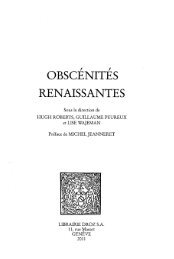Download (3398Kb) - ePrints Soton - University of Southampton
Download (3398Kb) - ePrints Soton - University of Southampton
Download (3398Kb) - ePrints Soton - University of Southampton
Create successful ePaper yourself
Turn your PDF publications into a flip-book with our unique Google optimized e-Paper software.
df= 31, P>0.05). However, the plot graph indicates that in waters shallower than 1000<br />
m, generally species with large body sizes are found, from 1000 to 3000 m species <strong>of</strong><br />
all body sizes occur and at depths greater than 3000 m only species with large body<br />
size are found (Fig. 4.4).<br />
The correlation between depth and egg size was proved to be not statistically<br />
significant (Spearman’s Rs= 0.136, df= 31, P>0.05) (Fig. 4.5).<br />
The Spearman’s correlation coefficient showed that no significant correlation<br />
exists between depth and Gonad Index (Rs= 0.297, df= 31, P>0.05). Therefore, these<br />
reproductive features <strong>of</strong> the asteroids do not have a direct positive or negative<br />
variation in relation to depth (Fig. 4.6).<br />
The results <strong>of</strong> both Hierarchical cluster analysis and MDS showed species<br />
clustering in three groups, according to maximum adult size, maximum egg size and<br />
maximum Gonad Index (Figs. 4.7, 4.8).<br />
The first group which was labelled as A contains 10 species which have small<br />
adult size. Their major radius (R) ranges from 24 to 85 mm in length, the egg size is<br />
large with diameters ranging from 546 to 1444 µm and low Gonad Index, which<br />
values range from 2.11 to 5.59.<br />
76
















